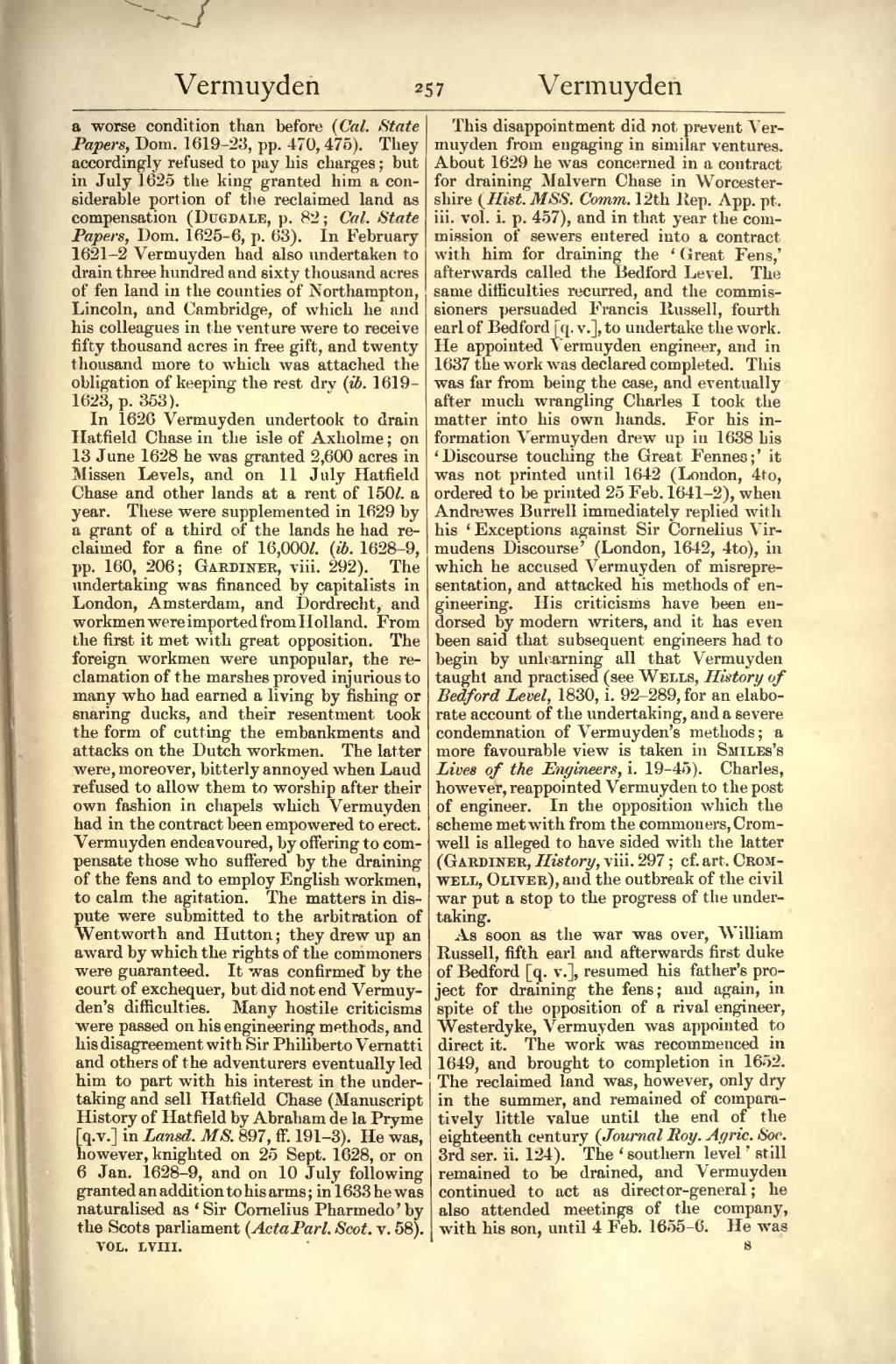a worse condition than before (Cal. State Papers, Dom. 1619–23, pp. 470, 475). They accordingly refused to pay his charges; but in July 1625 the king granted him a considerable portion of the reclaimed land as compensation (Dugdale, p. 82; Cal. State Papers, Dom. 1625–6, p. 63). In February 1621–2 Vermuyden had also undertaken to drain three hundred and sixty thousand acres of fen land in the counties of Northampton, Lincoln, and Cambridge, of which he and his colleagues in the venture were to receive fifty thousand acres in free gift, and twenty thousand more to which was attached the obligation of keeping the rest dry (ib. 1619–1623, p. 353).
In 1626 Vermuyden undertook to drain Hatfield Chase in the isle of Axholme; on 13 June 1628 he was granted 2,600 acres in Missen Levels, and on 11 July Hatfield Chase and other lands at a rent of 150l. a year. These were supplemented in 1629 by a grant of a third of the lands he had reclaimed for a fine of 16,000l. (ib. 1628–9, pp. 160, 206; Gardiner, viii. 292). The undertaking was financed by capitalists in London, Amsterdam, and Dordrecht, and workmen were imported from Holland. From the first it met with great opposition. The foreign workmen were unpopular, the reclamation of the marshes proved injurious to many who had earned a living by fishing or snaring ducks, and their resentment took the form of cutting the embankments and attacks on the Dutch workmen. The latter were, moreover, bitterly annoyed when Laud refused to allow them to worship after their own fashion in chapels which Vermuyden had in the contract been empowered to erect. Vermuyden endeavoured, by offering to compensate those who suffered by the draining of the fens and to employ English workmen, to calm the agitation. The matters in dispute were submitted to the arbitration of Wentworth and Hutton; they drew up an award by which the rights of the commoners were guaranteed. It was confirmed by the court of exchequer, but did not end Vermuyden's difficulties. Many hostile criticisms were passed on his engineering methods, and his disagreement with Sir Philiberto Vernatti and others of the adventurers eventually led him to part with his interest in the undertaking and sell Hatfield Chase (Manuscript History of Hatfield by Abraham de la Pryme [q. v.] in Lansd. MS. 897, ff. 191–3). He was, however, knighted on 25 Sept. 1628, or on 6 Jan. 1628–9, and on 10 July following granted an addition to his arms; in 1633 he was naturalised as ‘Sir Cornelius Pharmedo’ by the Scots parliament (Acta Parl. Scot. v. 58).
This disappointment did not prevent Vermuyden from engaging in similar ventures. About 1629 he was concerned in a contract for draining Malvern Chase in Worcestershire (Hist. MSS. Comm. 12th Rep. App. pt. iii. vol. i. p. 457), and in that year the commission of sewers entered into a contract with him for draining the ‘Great Fens,’ afterwards called the Bedford Level. The same difficulties recurred, and the commissioners persuaded Francis Russell, fourth earl of Bedford [q. v.], to undertake the work. He appointed Vermuyden engineer, and in 1637 the work was declared completed. This was far from being the case, and eventually after much wrangling Charles I took the matter into his own hands. For his information Vermuyden drew up in 1638 his ‘Discourse touching the Great Fennes;’ it was not printed until 1642 (London, 4to, ordered to be printed 25 Feb. 1641–2), when Andrewes Burrell immediately replied with his ‘Exceptions against Sir Cornelius Virmudens Discourse’ (London, 1642, 4to), in which he accused Vermuyden of misrepresentation, and attacked his methods of engineering. His criticisms have been endorsed by modern writers, and it has even been said that subsequent engineers had to begin by unlearning all that Vermuyden taught and practised (see Wells, History of Bedford Level, 1830, i. 92–289, for an elaborate account of the undertaking, and a severe condemnation of Vermuyden's methods; a more favourable view is taken in Smiles's Lives of the Engineers, i. 19–45). Charles, however, reappointed Vermuyden to the post of engineer. In the opposition which the scheme met with from the commoners, Cromwell is alleged to have sided with the latter (Gardiner, History, viii. 297; cf. art. Cromwell, Oliver), and the outbreak of the civil war put a stop to the progress of the undertaking.
As soon as the war was over, William Russell, fifth earl and afterwards first duke of Bedford [q. v.], resumed his father's project for draining the fens; and again, in spite of the opposition of a rival engineer, Westerdyke, Vermuyden was appointed to direct it. The work was recommenced in 1649, and brought to completion in 1652. The reclaimed land was, however, only dry in the summer, and remained of comparatively little value until the end of the eighteenth century (Journal Roy. Agric. Soc. 3rd ser. ii. 124). The ‘southern level’ still remained to be drained, and Vermuyden continued to act as director-general; he also attended meetings of the company, with his son, until 4 Feb. 1655–6. He was
